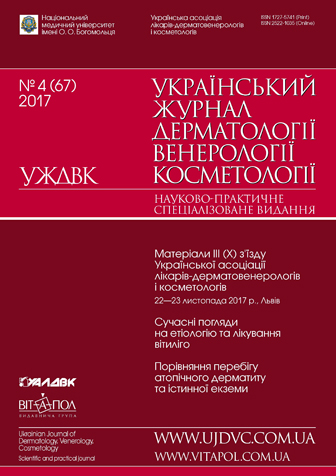- Issues
- About the Journal
- News
- Cooperation
- Contact Info
Current Issue. Articles
¹4(67) // 2017

1. Scientific researches
|
Notice: Undefined index: pict in /home/vitapol/ujdvc.vitapol.com.ua/en/svizhij_nomer.php on line 76 Clinical and pathogenetical comparison of atopic dermatitis and true eczema courseO.D. AleksandrukIvano-Frankivsk National Medical University |
|---|
Materials and methods.129 adults with atopic dermatitis and chronic true eczema were examined. Clinical and diagnostically important features were compared as well as clinical effectiveness of the treatment, secretion of serum IgE, IFN-γ, and IL4 in course.
Results and discussion. It was determined that diagnostics criteria of atopic dermatitis often presented in patients with true eczema but setting frequency of minor criteria presence was of great importance for differential diagnosis. Two different from pathogenesis point of view variants of atopic dermatitis and true eczema were determined based on serum IgE level: one with high total serum IgE and corelation between IL4 and the disease severity, the other with normal IgE level and dependence of the disease severity on IFN-γ secretion. Due to crossover increase of IFN-γ synthesis in patients with IgEdependent course of disease the common duration of in patient treatment phase is longer. Out patient followup of such patients requires continuation of systemic antihistamine treatment.
Conclusions. Our data shows that both atopic dermatitis and true eczema in adults have common clinical and pathogenic features and two slightly different variants of course. Variant for both diseases is connected with longer duration of in-patient management and necessity to continue with systemic antihistamine treatment during early follow-up.
Keywords: atopic dermatitis, true eczema, interleukin, treatment.
![]() To download
To download
full version need login
Original language: Ukrainian
2. Scientific researches
|
Notice: Undefined index: pict in /home/vitapol/ujdvc.vitapol.com.ua/en/svizhij_nomer.php on line 76 Metabolic activity of peripheral blood phagocytes in acneA.S. Swyryd-DzyadykevychO.O. Bogomolets National Medical University, Kyiv |
|---|
Materials and methods. We observed 47 patients with acne (19 men and 28 women aged 16 to 37 years) who composed the first group . The duration of the disease ranged from 7 months to 16 years. 22 patients had a mild degree of the pathological process, and in 25 patients, the average one was diagnosed. The second control group was formed by 15 healthy individuals, comparable in gender and age. All the patients were previously treated independently and in medical institutions. Systemic antibiotics and antiandrogens, topical retinoids, antiseptics were used. Three patients were administrated Aknetin for 1 month, but had to stop taking the drug because of financial insolvency. The effectiveness of the treatment was temporary or absent.
A general clinical examination of observed patients showed no pathological abnormalities. The indicators of general blood, urine, blood glucose, feces for the presence of helminths remained within physiological values. The glycogen content was studied in neutrophils and peripheral blood monocytes by supplying a PAS reaction, the results of which were assessed by the determination of the average cytochemical coefficient (CSC). Statistical processing of obtained data was carried out using the computer program Microsoft Excel.
Results and discussion. Patients with acne have a redistribution of glycogen content in peripheral blood leukocytes depending on the clinical course of the pathological process. This indicates changes in the energy potential of their individual subpopulations. In particular, the metabolite content in neutrophils at a mild degree of dermatosis severity decreased to CSC = 2.05 ± 0.05 (in individuals of the control group SCC = 2.31 ± 0.08, p < 0.05). These values were formed due to inhibiting the total number of PAS-positive cells and gnomelets with an average glycogen content with an increase in the specific gravity of granulocytes with a low saturation of the metabolite. Reduction of CSC to 1.72 ± 0.12 (p < 0.05) with an average degree of severity of acne was caused by an even more pronounced inhibition of the total number of PAS-positive neutrophils and cells with an average glycogen content. However, the specific gravity of the gnomelets with a low saturation of the metabolite remained within the limits of physiological fluctuations. In monocytes, SCC also increased, reaching 0.98 ± 0.06 (for individuals in the control group SCC = 0.70 ± 0.03, p < 0.05) for mild disease, and for an average of (1.14 ± 0.05, p < 0.05). These values were mainly due to an increase in the total number of PAS-positive cells with a high metabolite content.
Conclusions. Thus, in patients with acne in peripheral blood neutrophils, the content of glycogen is suppressed, which is accompanied by an increase in the level of metabolite in monocytes. This indicates a reorganization of the metabolic activity of phagocytes. Its decrease in neutrophils is compensated by an increase in monocytes. Such redistribution, respectively, reflects changes in the functional capacity of cells, which should be taken into account when choosing therapeutic tactics.
Keywords: acne, metabolically active therapy for acne, glycogen.
![]() To download
To download
full version need login
Original language: Ukrainian
3. Scientific researches
|
Notice: Undefined index: pict in /home/vitapol/ujdvc.vitapol.com.ua/en/svizhij_nomer.php on line 76 Analysis of vascularization and extracellular matrix degradation processes in actinic keratosisV.S. HlushokTernopil Regional Dermatovenerologic Dispensary |
|---|
Materials and methods. The immune histochemical study of vascularization and stromal degradation processes in 24 skin panchibioptates (15 actinic keratosis and 9 seborrheic keratosis) with markers CD34, MMP-9 and TIMP-1 (Thermo Scientific, USA) was carried out.
Results and discussion. A significant increase in the diameter and number of vessels in the actinic keratosis group was found in comparison with seborrheic keratosis (p < 0.05). When evaluating the proteolytic activity in the samples of the compared subgroups, a relatively strong correlation was observed for the expression of MMP9 (p < 0.05). The presence of aberrant expression of MMP-9 and TIMP-1 in both subgroups additionally indicates the presence of cellular atypia and serves as a reliable predictor of increased proliferative activity.
Conclusions. As a result of the vascularization analysis among the research groups, the probable increase of the quantity of vessels in AK in comparison with SK and the increase of the vessels diameter in AK group were found. The presence of aberrant expression of MMP-9 marker and TIMP-1 additionally testifies the presence of the cell atypia and can be a reliable prognostic indicator of the proliferative activity increasing.
Keywords: actinic keratosis, seborrheic keratosis, diagnosis, CD34, MMP-9, TIMP-1.
![]() To download
To download
full version need login
Original language: Ukrainian
4. Scientific researches
|
Notice: Undefined index: pict in /home/vitapol/ujdvc.vitapol.com.ua/en/svizhij_nomer.php on line 76 Method of determination and establishment of the acantholytic process severity on the oral cavity mucosa in patients with acantholityc pemphigusB.L. Genyk, M.M. Rozhko, V.Ye. TkachIvano-Frankivsk National Medical University |
|---|
Materials and methods. We have studied the effect of acantholytic pemphigus on the prosthetic bed tissues condition in 20 patients with acantholytic pemphigus. The following techniques were used to evaluate the condition of the oral mucosa: the determination of lesions area on oral mucosa, using the modified method of O.S. Gileva (by Nurieva N.S.); classical determination of Nikolsky symptom; determination and establishment of the acantholytic process severity degree by the proposed method.
Results and discussion. Acantholytic process on the oral cavity mucosa in patients with acantholytic pemphigus is one of the main factors in the clinic and the pathogenesis of this disease. The acantholytic process of various severity degrees depends on the duration of the disease and the glucocorticoid therapy intensity. With the increase of the severity degree of the acantholytic process, the area of lesions is increasing as well.
Conclusions. Tools and methods, proposed by us, will allow to timely diagnose the severity degree of acantholytic pemphigus of the oral mucosa, and the acantholytic process severity degree determination — to prescribe appropriate doses of glucocorticoids.
Keywords: acantholytic pemphigus, diagnostics, treatment, affected area, severity degree, acantholysis.
![]() To download
To download
full version need login
Original language: Ukrainian
5. Pharmacotherapy in dermatology and venereology
|
Notice: Undefined index: pict in /home/vitapol/ujdvc.vitapol.com.ua/en/svizhij_nomer.php on line 76 Topical metronidazole in the treatment of rosaceaL.A. BolotnaKharkiv Medical Academy of Postgraduate Education |
|---|
Materials and methods. 40 patients with papulopustular rosacea subtype were under observation. Rozamet® was prescribed in the form of monotherapy with mild severity or as part of combination therapy at moderate severity. The effectiveness of the therapy was studied based on the dynamics of the scale of the diagnostic evaluation of rosacea and the frequency of dermatosis relapses .
Results and discussion. High efficacy (22.5 % clinical cure, 62.5 % significant improvement) of Rozamet® cream 2 times a day for 8 weeks is shown. Continuation of external cream therapy once a day for 8 weeks contributed to the regress of clinical manifestations, reducing the number of relapses by 4 times.
Conclusions. Topical metronidazole 1 % (Rozamet® cream) is the drug of choice in the external treatment of the papulopustular subtype of rosacea. The use of Rozamet® cream is possible as a longterm maintenance therapy for rosacea.
Keywords: rosacea, pathogenesis, treatment, metronidazole 1 % (cream), Rozamet®, efficacy.
![]() To download
To download
full version need login
Original language: Russian
6. Reviews
|
Notice: Undefined index: pict in /home/vitapol/ujdvc.vitapol.com.ua/en/svizhij_nomer.php on line 76 Current updates about vitiligoC. DiehlUniversitá Degli Studi Guglielmo Marconi, Rome, Italy |
|---|
Keywords: Vitiligo, pigmentation, aetiology, pathogenesis, treatment.
Notice: Undefined index: attach in /home/vitapol/ujdvc.vitapol.com.ua/en/svizhij_nomer.php on line 177
Original language: English
7. Reviews
|
Notice: Undefined index: pict in /home/vitapol/ujdvc.vitapol.com.ua/en/svizhij_nomer.php on line 76 Immunopathogenesis of psoriasis combined with the 1st and 2nd type of herpesvirusU.V. Fedorova, O.O. SyzonDanylo Halytskiy Lviv National Medical University |
|---|
Materials and methods. On the basis of literature sources analysis and own observations (clinical, laboratory) we arranged and described several immunopathogenetic features of psoriasis development in combination with herpesvirus of the 1st and 2nd type.
Results and discussion. Recent studies have shown that psoriasis is often synergistically combined with herpesvirus of the 1st and 2nd type, which determines the severity, frequency of recurrences, and the course of this dermatosis. The interaction of components of an innate immune response, cellular and humoral parts of the immune system is carried out through the cytokine network. Therefore, the article considers features of cytokine response at isolated HSV infection and in combination with the psoriatic process. Recently, new biomarkers, i. e. a system of small ribonucleic microRNA acids, have been described. Their role and interconnection in terms of regulation of congenital and acquired immunity activity in patients with herpesvirus infection at psoriasis have been defined. The basis to use microRNA as a biomarker of processes activity is its resistance to nucleoside cleavage; therefore, it is preserved in the bloodstream and can be measured. Recent studies on molecular genetics suggest that the epigenetic microRNA system can regulate the activity of immune response and can be significantly changed at early stages of autoimmune diseases, psoriasis in particular. In addition, it can affect the activation of recession of herpesvirus infection of the 1st and 2nd type.
Conclusions. Thus, the immunopathogenetic aspects of psoriasis are of a versatile nature. The issues of allelic polymorphism LMP2 (lysosomal membrane protein) influence on the effectiveness of phagocytosis in psoriatic patients against the background of the activity of herpesvirus infection of the 1st and 2nd type and participation of regulatory T-lymphocytes in the development of autoimmune process and antiviral defence are still unknown. In addition, there is a need to assess immunoregulatory effects of the miR146a system, 155 on the formation of immune response in such patients. There is no structured integrated and differentiated approach to the treatment tactics. This illustrates the viability of further studying of immunopathogenetic mechanisms of psoriasis in order to determine the links that are subjected to therapeutic correction and the pathogenetic role of immune factors in triggering the inflammatory process at psoriasis.
Keywords: psoriasis, herpes simplex virus of the 1st/2nd type, clinical picture, immunopathogenesis.
![]() To download
To download
full version need login
Original language: Ukrainian
Log In
Notice: Undefined variable: err in /home/vitapol/ujdvc.vitapol.com.ua/blocks/news.php on line 51

